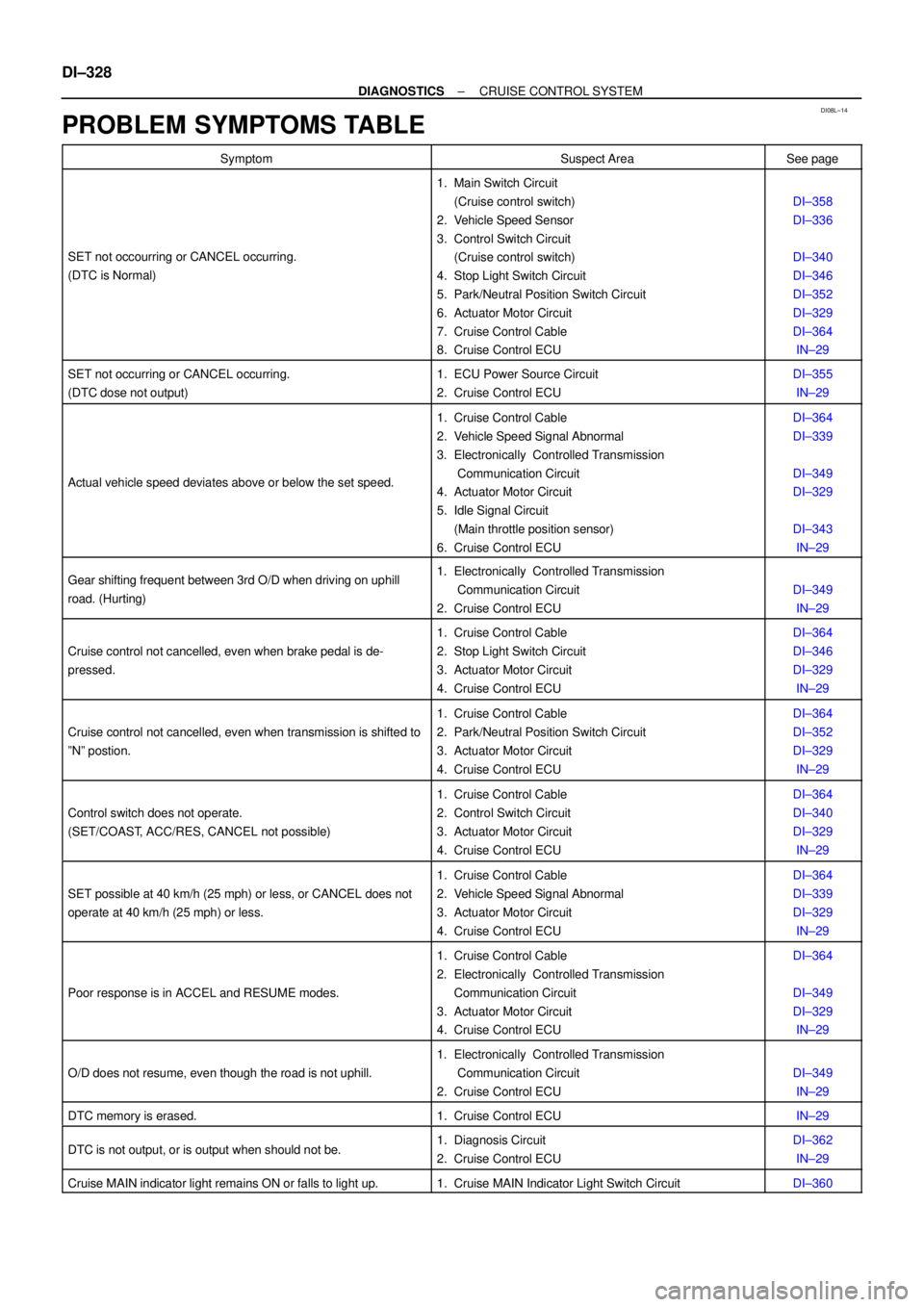Page 2480 of 4592

DI08L±14
DI±328
± DIAGNOSTICSCRUISE CONTROL SYSTEM
PROBLEM SYMPTOMS TABLE
SymptomSuspect AreaSee page
SET not occourring or CANCEL occurring.
(DTC is Normal)
1. Main Switch Circuit
(Cruise control switch)
2. Vehicle Speed Sensor
3. Control Switch Circuit
(Cruise control switch)
4. Stop Light Switch Circuit
5. Park/Neutral Position Switch Circuit
6. Actuator Motor Circuit
7. Cruise Control Cable
8. Cruise Control ECU
DI±358
DI±336
DI±340
DI±346
DI±352
DI±329
DI±364
IN±29
SET not occurring or CANCEL occurring.
(DTC dose not output)1. ECU Power Source Circuit
2. Cruise Control ECUDI±355
IN±29
Actual vehicle speed deviates above or below the set speed.
1. Cruise Control Cable
2. Vehicle Speed Signal Abnormal
3. Electronically Controlled Transmission
Communication Circuit
4. Actuator Motor Circuit
5. Idle Signal Circuit
(Main throttle position sensor)
6. Cruise Control ECUDI±364
DI±339
DI±349
DI±329
DI±343
IN±29
Gear shifting frequent between 3rd O/D when driving on uphill
road. (Hurting)1. Electronically Controlled Transmission
Communication Circuit
2. Cruise Control ECU
DI±349
IN±29
Cruise control not cancelled, even when brake pedal is de-
pressed.
1. Cruise Control Cable
2. Stop Light Switch Circuit
3. Actuator Motor Circuit
4. Cruise Control ECUDI±364
DI±346
DI±329
IN±29
Cruise control not cancelled, even when transmission is shifted to
ºNº postion.
1. Cruise Control Cable
2. Park/Neutral Position Switch Circuit
3. Actuator Motor Circuit
4. Cruise Control ECUDI±364
DI±352
DI±329
IN±29
Control switch does not operate.
(SET/COAST, ACC/RES, CANCEL not possible)
1. Cruise Control Cable
2. Control Switch Circuit
3. Actuator Motor Circuit
4. Cruise Control ECUDI±364
DI±340
DI±329
IN±29
SET possible at 40 km/h (25 mph) or less, or CANCEL does not
operate at 40 km/h (25 mph) or less.
1. Cruise Control Cable
2. Vehicle Speed Signal Abnormal
3. Actuator Motor Circuit
4. Cruise Control ECUDI±364
DI±339
DI±329
IN±29
Poor response is in ACCEL and RESUME modes.
1. Cruise Control Cable
2. Electronically Controlled Transmission
Communication Circuit
3. Actuator Motor Circuit
4. Cruise Control ECUDI±364
DI±349
DI±329
IN±29
O/D does not resume, even though the road is not uphill.
1. Electronically Controlled Transmission
Communication Circuit
2. Cruise Control ECU
DI±349
IN±29
DTC memory is erased.1. Cruise Control ECUIN±29
DTC is not output, or is output when should not be.1. Diagnosis Circuit
2. Cruise Control ECUDI±362
IN±29
Cruise MAIN indicator light remains ON or falls to light up.1. Cruise MAIN Indicator Light Switch CircuitDI±360
Page 2483 of 4592

I00281
Cruise Control ECU
C16
G±B
2 1 34W±B
3
STOP Fuse8 Stop Light Switch
4
R±Y
Stop Lights Cruise Control Actuator
� Actuator Magnetic Clutch
J6
J6AAJ/C
W±B
1J
1J
W±B
A
J/C
IF 8
7
J9Instrument
Panel J/BL
± DIAGNOSTICSCRUISE CONTROL SYSTEM
DI±331
DTC 12 Actuator Magnetic Clutch Circuit
CIRCUIT DESCRIPTION
This circuit turns on the magnetic clutch inside the actuator during cruise control operation according to the
signal from the ECU. If a malfunction occurs in the actuator or speed sensor, etc. during cruise control opera-
tion, the rotor shaft between the motor and control plate is released.
When the brake pedal is depressed, the stop light switch turns on, supplying electrical power to the stop light.
Power supply to the magnetic clutch is mechanically cut and the magnetic clutch is turned OFF.
When driving downhill, if the vehicle speed exceeds the set speed by 15 km/h (9 mph), the ECU turns the
safety magnet clutch OFF. If the vehicle speed later drops to within 10 km/h (6 mph), cruise control at the
set speed is resumed.
DTC No.DTC Detecting ConditionTrouble Area
12Short in actuator magnetic clutch circuit.
Open (0.8 sec.) in actuator magnetic clutch circuit.
�STOP Fuse
�Stop light switch
�Actuator magnetic clutch
�Harness or connector between cruise control ECU and
actuator magnetic clutch, actuator magnetic clutch and body
ground
�Cruise control ECU
WIRING DIAGRAM
DI08N±13
Page 2484 of 4592
I00157
Instrument panel junction block No.1:
STOP Fuse
I00133
21
43
DI±332
± DIAGNOSTICSCRUISE CONTROL SYSTEM
INSPECTION PROCEDURE
1 Check STOP fuse.
PREPARATION:
(a) Turn ignition switch OFF.
(b) Remove the STOP fuse from instrument panel junction
block No.1.
CHECK:
Check fuse continuity.
OK:
There is continuity.
NG Replace STOP fuse.
OK
2 Check stop light switch.
PREPARATION:
Disconnect the stop light switch connector.
CHECK:
Check continuity between terminals.
Switch positionContinuity
Switch pin free
(Brake pedal depressed)1 ± 2
Switch pin pushed in
(Brake pedal released)3 ± 4
NG Replace stop light switch.
OK
Page 2489 of 4592
Input SignalIndicator Light
Blinking Pattern
Drive at about
40 km/h (25 mph)
or below
Drive at about
40 km/h (25 mph)
or higherLightON
OFF
LightON
OFF
± DIAGNOSTICSCRUISE CONTROL SYSTEM
DI±337
INSPECTION PROCEDURE
1 Input signal check.
CHECK:
(a) See input signal check on page DI±319.
(b) Check indicator light operation when driving with vehicle
speed above 40 km/h (25 mph), and with vehicle speed
below 40 km/h (25 mph).
OK:
Vehicle speed above 40 km/h (25 mph):
Indicator light blinks
Vehicle speed below 40 km/h (25 mph):
Indicator light stays on
OK Check and replace cruise control ECU
(See page IN±29).
NG
2 Check speedometer circuit (See Combination meter troubleshooting on page
BE±1).
NG Repair or replace harness, connector or com-
bination meter assembly.
OK
3 Check harness and connector between cruise control ECU and combination me-
ter, combination meter and vehicle speed sensor (See page IN±29).
NG Repair or replace harness or connector.
OK
Page 2493 of 4592

Input SignalIndicator Light
Blinking Pattern
SET/COAST
switch
RESUME/ACCEL
switch
CANCEL switch2 Pulses
ON
OFF
ON
OFF3 Pulses
ON
OFFSW OFF
SW ON
AB0119
I00168
I00171
ON
CCS
(±) (+)
± DIAGNOSTICSCRUISE CONTROL SYSTEM
DI±341
INSPECTION PROCEDURE
1 Input signal check.
PREPARATION:
See input signal check on page DI±319.
CHECK:
Check the indicator light operation when each of the SET/
COAST, RESUME/ACCEL and CANCEL is turned on.
OK:
SET/COAST, RESUME/ACCEL switch
The signals shown in the table on the left should be
output when each switch is ON. The signal should
disappear when the switch is turned OFF.
CANCEL switch
The indicator light goes off when the cancel switch is
turned ON.
OK Wait and see.
NG
2 Check voltage between terminals CCS of cruise control ECU connector and body
ground.
PREPARATION:
(a) Remove the ECU with connector still connected.
(b) Turn ignition switch ON.
CHECK:
Measure voltage between terminals 18 of ECU connector and
body ground, when each of the SET/COAST, RESUME/AC-
CEL and CANCEL is turned ON.
Switch positionResistance (V)
Neutral10 ± 16 V
RES/ACC0.8 ± 3.7 V
SET/COAST2.5 ± 6.3 V
CANCEL4.2 ± 8.8 V
NG Proceed to next circuit inspection shown on
problem symptoms table (See page DI±328).
OK
Page 2498 of 4592

I08461
A
J6A
J6 J/C
J/CJ9
A
W±BW±B
Instrument Panel J/B
7
1J
1J8
IF Battery FL MAIN B±G1
F9FL BLOCK
ALT
F141B±R 7
1C4
1B Instrument Panel J/B
STOP W2
3Stop Light Switch
1
4G±W1R4 Instrument Panel J/B
5
1R
R±Y
G±B
W±BCruise Control
Actuator
3
4G±WAA J23
J/C
G±W2
C16
C16
8Cruise Control ECU
STP±
L
DI±346
± DIAGNOSTICSCRUISE CONTROL SYSTEM
Stop Light Switch Circuit
CIRCUIT DESCRIPTION
When the brake pedal is depressed, the stop light switch sends a signal to the ECU. When the ECU receives
this signal, it cancels the cruise control.
A fail±safe function is provided so that the cancel functions normally, even if there is a malfunction in the stop
light signal circuit.
The cancel conditions are: Battery positive voltage at terminal STP±
When the brake is ON, battery positive voltage normally is applied through the STOP fuse and stop light
switch to terminal STP± of the ECU, and the ECU turns the cruise control OFF.
If the harness connected to terminal STP± has an open circuit, terminal STP± will have battery positive volt-
age and the cruise control will be turned OFF.
Also, when the brake is ON, the magnetic clutch circuit is cut mechanically by the stop light switch, turning
the cruise control OFF. (See page DI±331 for operation of the magnetic clutch)
WIRING DIAGRAM
DI08T±12
Page 2499 of 4592
Input SignalIndicator Light
Blinking Pattern
Stop Light
switch ON
LightOFF
ONSW OFF
SW ON
± DIAGNOSTICSCRUISE CONTROL SYSTEM
DI±347
INSPECTION PROCEDURE
1 Check operation of stop light.
CHECK:
Check that stop light comes ON when brake pedal is depressed, and turns OFF when brake pedal is re-
leased.
NG Check stop light system (See page BE±1).
OK
2 Input signal check.
CHECK:
(a) See input signal check on DI±319.
(b) Check the indicator light when the brake pedal is de-
pressed.
OK:
The indicator light goes OFF when the brake pedal is
depressed.
OK Proceed to next circuit inspection shown on
problem symptoms table (See page DI±328).
NG
Page 2500 of 4592
AB0119
I00142
I00173
ON
STP±
(±) (+)
DI±348
± DIAGNOSTICSCRUISE CONTROL SYSTEM
3 Check voltage between terminal STP± of cruise control ECU connector and
body ground.
PREPARATION:
(a) Remove the ECU with connectors still connected.
(b) Turn ignition switch ON.
CHECK:
Measure voltage between terminal STP± of cruise control ECU
connector and body ground, when the brake pedal is de-
pressed and released.
OK:
Depressed10 ± 14 V
ReleasedBelow 1 V
OK Proceed to next circuit inspection shown on
problem symptoms table (See page DI±328).
NG
4 Check for open in harness and connectors between terminal STP± of cruise con-
trol ECU and stop light switch (See page IN±29).
NG Repair or replace harness or connector.
OK
Check and replace cruise control ECU
(See page IN±29).